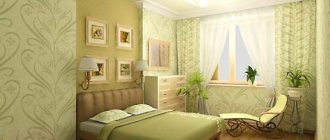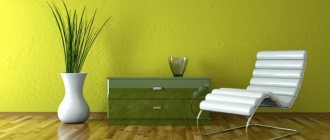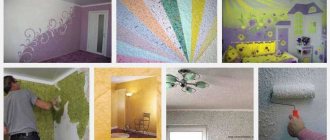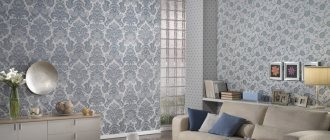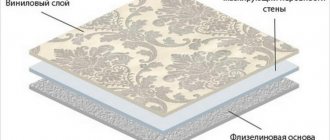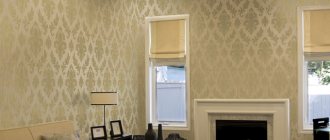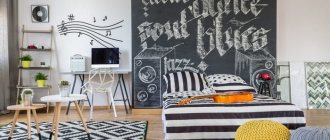“Hello, class! We take out our textbooks, open our notebooks, write down the topic of today’s lesson: a rectangular parallelepiped...” If you, like half the class, at these words have a vague feeling of slight boredom, do not rush to be disappointed. Then, in “adult” life, it turned out that without geometry you can’t build a house, you can’t calculate the area of an apartment, you can’t figure out how much wallpaper to buy - you won’t understand at all. There is always left or not enough. Imagine an engineer or a tailor without knowledge of geometry...
In general, science, which studies the shapes of objects and their interaction in space, is invisibly present everywhere. There is such a thing as “geometry of space”. In combination with the design, it determines whether you will be comfortable in the room or want to escape from there as quickly as possible.
Fine art turned to simple geometric forms at the beginning of the twentieth century. Cubism, Suprematism, abstractionism. Now the “geometric style” is popular in various areas of design - from apartment interiors to clothing and tattoos. And if you are partial to clear lines and simple shapes, you can add geometric patterns to the interior of your own apartment. Let's see what can come of this.
Geometry in different interior styles
In fact, strict geometric shapes can successfully fit into almost any interior. It’s another matter when the entire design of the room is based on simple lines and laconic colors. True fans of geometry will surely like minimalism and functionalism.
Constructivism came to interior design from architecture and fine arts. He brought practical forms and functionality to apartments. All for the sake of convenience and no frills. A laconic decor of geometric shapes (especially in the form of an allusion to some famous painting) will fit well into constructivism.
Cute Scandinavian style is famous for its simplicity, convenience and coziness. The decor and the feeling of airiness of the space are responsible for the coziness here. For convenience - functional furniture. For simplicity - the very principle of style. What could be simpler than simple geometric shapes? Textiles and decor with geometric patterns are especially popular in Scandi.
Contemporary style furniture and decor also shows a love for geometric shapes and patterns. If you mix Scandi, minimalism and constructivism, you get contemporary art. Modern, harmonious, for any premises and tasks.
Deconstructivism is suitable for bold experiments on large areas. This style arose at the intersection of philosophy and the denial of the principles of constructivism. Its main essence is to break the usual ideas about space. Tired of boring standard apartments? Deconstructivism will disassemble all the components of design into separate elements and put them in the most unexpected order!
Geometry may be different. Not necessarily within the strict framework of minimalist styles. Here, for example, is a modern classic. The same lines on the walls, but in tone with the rest of the design, look very harmonious.
Basic rules for using patterns in the interior
Geometric patterns in the interior are the simplest way to liven up the atmosphere and make the room individual. Using the proven advice of professional designers, you can avoid common mistakes and achieve the desired effect in the shortest possible time.
- The number of patterns involved must be odd. The fact is that the human eye always gives preference to an unpaired number of prints. Start experimenting with three to five geometric patterns, evaluate the result, think about how such wallpaper will combine with the surrounding space. Add more elements if necessary.
- In one room, patterns of different sizes should be in harmonious combination. This means striking a balance between large, small and medium images. Therefore, if you want to see a large geometric print on the wallpaper, then the remaining details of the room should consist only of small or medium-sized ornaments.
- Choose large images for large items, and small ones for small ones. This is due to the characteristics of the space that the selected pattern will occupy. It is best to use large geometric images on walls, carpets and windows; medium - on accompanying furniture; small pictures - on auxiliary things (pillows, capes, etc.).
- Choose a dominant pattern and include the main color scheme of the interior in it. Such a pattern should be large, and all elements of the room should be combined with it. Once the given option is selected, in a similar way, choose the middle ornament that will be in harmony with all the small objects.
- If nothing fits, break all the rules. Experiments give birth to fresh ideas that may absolutely not correspond to design canons, but only through them can you fill the interior with comfort and your own style.
The above rules concerned the general principles of working with geometric patterns. Now let's focus on how best to use this element on wallpaper.
Walls. Dye
In the old days, in Russian realities, there was a terrible prejudice: every centimeter of the walls should be filled with furniture, hung with shelves, carpets, whatever, so that not a single centimeter would be “empty.” And the Oscar in the “designer’s nightmare” category goes to a hybrid of a shelving unit with a cabinet with mezzanines and a bar - a mutant of the Soviet furniture industry called the “wall”... Either people have fewer things, or they began to store them in some other way, but the walls rooms in the 21st century can finally breathe easy. They have become an important part of the interior, which should “work” on its own. Large geometric patterns on the walls can be made using paint and stencils precisely so that the “bare” walls do not appear so, but create a holistic picture of modern design.
Wallpaper design in small rooms
When choosing a pattern for a limited space, pay special attention to proportions:
- Use small patterns in small rooms.
- Large drawing - for large rooms.
- It’s easy to destroy a small space with a huge bright pattern.
Up close the drawings look different. A small drawing (pattern) from a distance is perceived simply as a dominant color, thereby creating a sophisticated addition to the interior. Therefore, before using wallpaper with a certain design, you should always first look at the composition from afar.
When choosing wallpaper for a small room, you need to be guided by the rules of visual expansion of space. It is recommended to give preference to horizontal stripes of medium thickness with unclear contours. And in rooms where there is not enough natural light, you should not use cold shades.
Wallpaper
The variety of wallpaper in stores can drive you crazy: a ton of materials, sizes and properties, not to mention millions of colors... How to choose exactly what you need? Read the article “how to choose wallpaper”. As for geometric patterns, they can be absolutely anything: zigzags, diamonds, circles, lines, triangles and squares. Choose the wallpaper color based on your own taste and general rules for color combinations. But the size of the patterns is usually directly proportional to the area of the room. Otherwise, small diamonds will dazzle the eyes in a large hall, and huge circles in a small living room can visually reduce its area. In order not to overload the interior, you can hang wallpaper with geometric patterns on only one wall, thus placing an emphasis on it.Striped wallpaper
Wall coverings decorated with stripes will never lose their popularity. This trend has been going on for many decades, and is not going to lose ground.
Thanks to the creativity of designers, a seemingly ordinary vertical or horizontal stripe can become a magnificent decor that matches any type of interior: elegant, mischievous, romantic, shocking.
Different widths and directions of stripes allow not only zoning, but also visually changing the space, making the room taller or wider.
Each canvas has its own design solution, opening up wide scope for the author's imagination. You can choose geometric wallpaper decorated with:
- Monochrome stripe
- Symmetrical,
- Various sizes,
- Rosary,
- blurry
- Contrasting,
- Created from light and darker shades of the same color.
We recommend choosing striped wallpaper if you want:
- experiment with spatial perception;
- visually delimit the room;
- make the room strict or, on the contrary, cheerful.
They can become both an attention-grabbing accent and a background. This is a truly universal option, striking in its versatility.
3D panels
3D cinema, a printer and cosmetic procedures - everything that has a 3D console must be modern and cool. 3D panels are so called because they are not flat, but three-dimensional. And in fact, they have been used since synthetic materials were invented. The advantage of 3D panels is that you can decorate a wall in an original way in one color, without resorting to posters and mirrors for decoration - they are simply not needed here. On the other hand, this is also a minus, because you can’t hang anything on such panels - not only decor, but also furniture, for example, shelves.
All about geometry in decor
First, let's decide what geometric patterns the canvas may have:
- Lines. These are not just stripes, but straight or wavy images.
- Circles of different diameters, simply outlined or “filled” with a certain color.
- Squares. The filling is exactly the same as with other shapes.
- Diamonds.
These are the main figures, but the choice does not end there; more than one figure can be placed on one canvas, in different sizes and in a certain order; fortunately, the price of the wallpaper does not depend on the location. (See also the article Types of finishes: features.)
An example of the main figure for this type of wallpaper
Furniture and wallpaper
Separately, it is worth immediately clarifying the point with the combination of furniture, curtains and geometry. The fact is that in the interior there is often an imbalance of these moments, and as a result the room turns out to be somewhat chaotic, from the point of view of the interior.
Therefore, let us clarify that, for example:
Geometric wallpaper for walls with large and bright patterns always attracts attention, and it is against their background that curtains should be not so bright, or even better, plain and without additional patterns on the fabric. As for the combination of wallpaper and furniture, exactly the same principle applies here: the brighter and larger the pattern, the calmer the surface of the furniture should be. The ideal could be a combination of a large pattern and plain, calm furniture, against the backdrop of smooth and also plain curtains.
Plain furniture to match a specific pattern on the walls
Drawing and room
Now let's talk about the main thing, for which room, which pattern is best suited, what you should pay attention to, and what principles to follow. The instructions will be as accurate and interesting as possible.
(See also the article Wall decoration: options.)
In general, starting with stripes, it is important to find harmony in their use; being too carried away with horizons or vertical stripes can visually introduce an imbalance into the room; it seems to be wider, but lower, or higher, but narrower. So in these cases, you can turn to designers for advice.
Different stripe directions have different effects on the visual perception of the room
Finishing the conversation about the band, let’s clarify one more interesting point - frequency and width. You can use completely different combinations, but you need to remember that the more often the stripe appears, regardless of whether it is vertical or horizontal, the more it can tire the eye.
It is important to maintain the width of the strip
Here the conclusion immediately suggests itself that in a small room it is best to abandon stripes altogether, or choose wallpaper with a completely blurred, barely perceptible pattern.
Furniture
And here are the shelves. You can experiment with them as much as you like! From the end, the shelf looks like a line, which means that from these “lines” you can create any pattern, for example, something like an Indian mandala. Such designs are usually made to order as a cool art object for an apartment.
And here are another exhibits worthy of exhibition halls in museums of modern art - designer tables. Their creators were clearly inspired by nature and jewelry craftsmanship, drawing associations with stones and diamond faces.
Tile
Any ceramic tile can be classified as geometry in the interior. It is difficult to find an apartment without tiles at all; most often they are used to decorate the bathroom and kitchen splashback. A more original solution is a kitchen island or part of the wall. Original and soulful.
What to combine with?
Zoning a room with wallpaper, that is, using two (or three) companion wallpapers is more relevant than ever. For example, part of the wall can be highlighted with 3D wallpaper, while others are decorated with wallpaper of the same shade, but without this visual effect. Another technique that allows you to create beautiful interiors is accent walls. Designers cover one wall with patterned wallpaper, and decorate the rest with paint or neutral wallpaper. This decor requires almost no “support” in the interior.
Wallpaper Decoprint, Sphere. Photo: deco-print.be
Wallpaper Decoprint, Sphere. Photo: deco-print.be
Carpets
Do you love minimalist design, but are you afraid that your apartment might be boring? Focus on one thing, such as a rug. It doesn’t matter whether it’s black and white or color – geometric patterns on carpets never lose their relevance.
Rectangles, squares, diamonds
Not so often, but still there are patterns in the form of simple geometric shapes, such as squares, rectangles, diamonds.
The use of squares and rectangles gives the room a calm, balanced look. These patterns have little dynamics compared to the same stripes, so the use of such quadrangles will help create a feeling of certain solidity and peace in the room. This is the most orderly option of all geometric patterns in rooms. Additionally, using frequently repeating squares (or rectangles) is great for a spacious room, while occasional free-standing shapes will make a small space feel a little bigger.
Textile
Curtains, pillows and blankets are indispensable textiles in any interior. They add comfort and decorate the interior. Textiles with geometric patterns are universal, as they are neutral in design and suit many styles. As a last resort, you can always replace it, if you get tired of it, with something else and without much expense.
Geometric patterns on the upholstery of armchairs and chairs look stylish. The shapes themselves may be different, but by choosing a single color scheme, you will still get furniture that will match each other. The upholstery can be made to order - a second life for an old chair and an exclusive item for your interior.
Types of geometric patterns on wallpaper
Geometric and abstract designs are classified from simple to complex - from spots or rhythmic motifs to complex ones that completely fill the plane.
Stripes - a classic wallpaper pattern
Stripes on wallpaper can outline or even change a space. Stripes in the interior are universal and can be monochromatic or multi-colored, narrow or wide, frequent or rare. They are very popular and perfectly complement interiors in classic styles.
Wallpaper with horizontal stripes
The influence of stripes on the geometry of the room:
- A vertically directed pattern can visually make the ceiling higher.
- The horizontal strip expands the surface on which it is glued.
- The diagonal direction is the most interesting - it can erase boundaries and corners, making long and elongated rooms more square.
Wallpaper with vertical stripes
Be careful, the thinner and more contrasting in shade the stripes are, the more space they will hide. Wider stripes of shades close to each other will not make the room smaller.
Wallpaper with zigzag (herringbone)
The zigzag pattern is a bold solution for modern interiors. Zigzag perfectly blurs boundaries and smoothes out any irregularities or protrusions. The pattern itself is very dynamic and lively, so you shouldn’t overuse it.
Wallpaper with zigzag
The herringbone on the wallpaper can be either clearly defined, when the color of the pattern is contrasting with the color of the base, or more calm. Wallpaper with a contrasting pattern is best used to decorate one wall or part of it. If the zigzag is not very catchy, then all the walls can be covered with this wallpaper.
Diamonds and triangles on wallpaper
Wallpaper with rhombuses and triangles in different shades of the same color, made in muted, pastel colors, is suitable for classic interiors. These geometric patterns can add both lightness and energy to the interior.
If the rhombic contour on the wallpaper is formed by thin light lines on a muted background, then such a finishing material will be acceptable for finishing all the walls of the room.
Wallpaper with rhombuses in the interior
Diamonds of different sizes and different colors, as well as an excessively contrasting pattern, add dynamics. This wallpaper is best used to decorate an accent wall.
Checkered wallpaper
Tartan is a checkered design consisting of horizontal and vertical stripes, as well as rectangular areas filled with diagonal stripes. This pattern is very cozy and harmonizes perfectly with furniture made from natural wood.
Checkered wallpaper in the interior
A larger cage in other colors is often used to decorate rooms in a classic style.
Squares, rectangles on wallpaper
Squares or rectangles are a calmer pattern that is often used in Scandinavian interiors. It looks restrained, harmonious and does not overload the interior with excessive dynamics.
Squares on wallpaper in the interior
By choosing wallpaper with contrasting square colors, you can liven up a monochrome interior and give it character.
Lighting
There is plenty of room to explore geometries in lighting! LED panels and strips will fit perfectly into hi-tech and minimalism, combining with the lines of the rest of the decor.
Geometry looks fresh and modern in the design of chandeliers, echoing other interior elements or, on the contrary, contrasting with them.
Non-traditional uses
If you are not yet ready to cover the entire room with wallpaper with a geometric pattern, try using it only as decoration. Here are the top 7 options for using wallpaper with various types of geometric patterns in non-standard places and situations:
- If you have a small but well-ventilated bathroom, you can try wallpapering it with waterproof wallpaper with geometric patterns. This pattern goes well with marble and bronze bathroom decor elements. Remember that it is better to glue wallpaper in the bathroom only on two-thirds of the wall. The lower third of the wall should be covered with tiles.
- With the help of geometric wallpaper you can put an accent on any wall. For example, you want to attract the attention of room visitors to a stylish painting. Cover the wall with the painting with geometric wallpaper, the color of which will contrast with the color scheme of the painting.
- Cover the walls behind shelves and cabinets with transparent back walls with this wallpaper. This way, you will create an original background for family photos and other small items placed on the shelves.
- If the walls in your room are covered with wood paneling, then geometric wallpaper can be glued above it. In this case, the most successful solution is a simple classic ornament.
- Place wallpaper with a beautiful, unusual geometric pattern in a large wooden frame. This way you will create your own, very original and stylish work of art.
- Geometric wallpaper can add a refined and sophisticated flair to even such a simple object as a staircase if you cover the vertical part of the steps with it. To prevent your wallpaper from wearing out too quickly, protect it with a thin layer of acrylic glass.
- Wallpapering ceilings is back in fashion. Use this trump card! Cover your ceiling with geometric wallpaper and give it an unforgettable look.
Decor
Geometry in decoration has almost become a new classic in modern design styles. Instead of expensive paintings - laconic posters, instead of gilded baguettes for them - simple black or white frames. Paintings, of course, have not gone away, but abstract images are becoming more and more popular; everyone can find some kind of meaning in them. Florariums in the shape of diamonds, octahedrons and other interesting geometric shapes fit perfectly into the idea of minimalism and Scandi - simply and tastefully. Conceptually, this is what we can say about the geometry in the interior as a whole. And if you haven't decided on a style yet, we have a cool style preference test!Geometry: pros and cons
Wall coverings with geometric patterns fit into many stylistic trends. The play of lines, different weaves, stripes - all this gives great scope for imagination. Properly selected material has the following advantages:
- make the room lighter and brighter;
- visually expand the boundaries and raise the ceiling;
- convey the taste and character of the owner;
- the room acquires originality.
In general, the geometry on the walls is positive. But there are also downsides: for a small room, completely covering it with large patterns is not suitable. The wrong choice of ornament can irritate the psyche and cause negative emotions.
When gluing, you need to carefully join the pattern, otherwise the aesthetic appearance will be lost and the material will lose its attractiveness.

